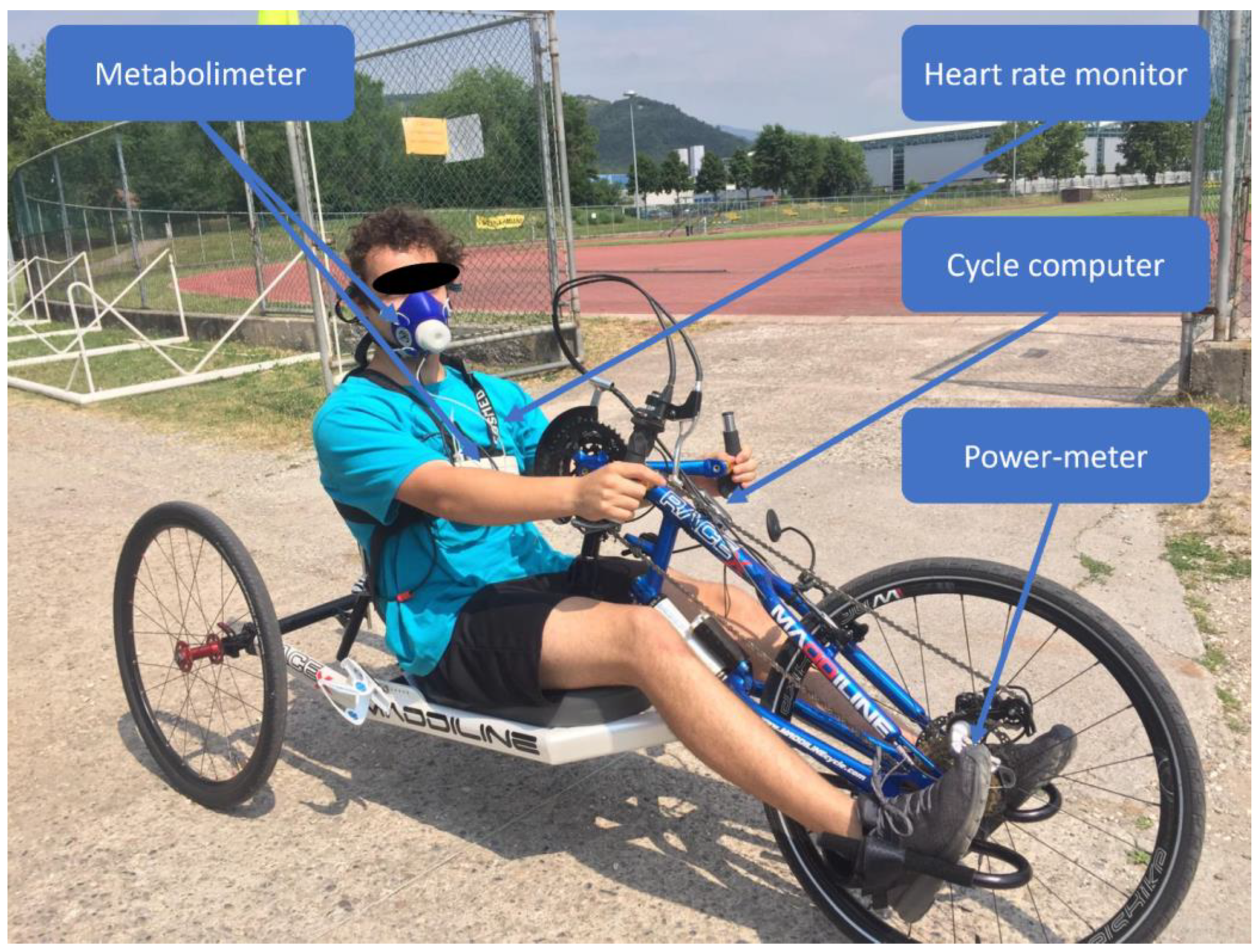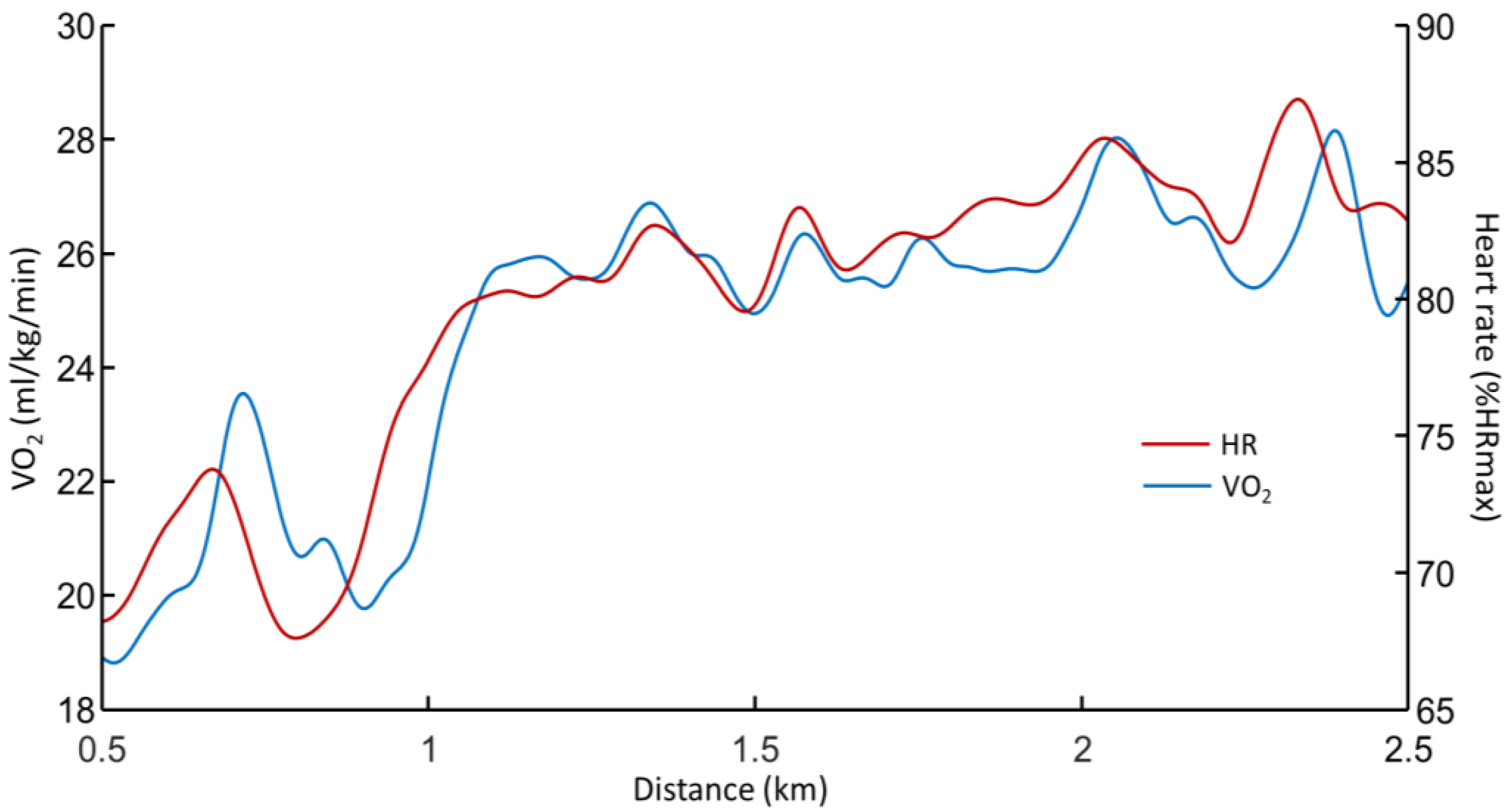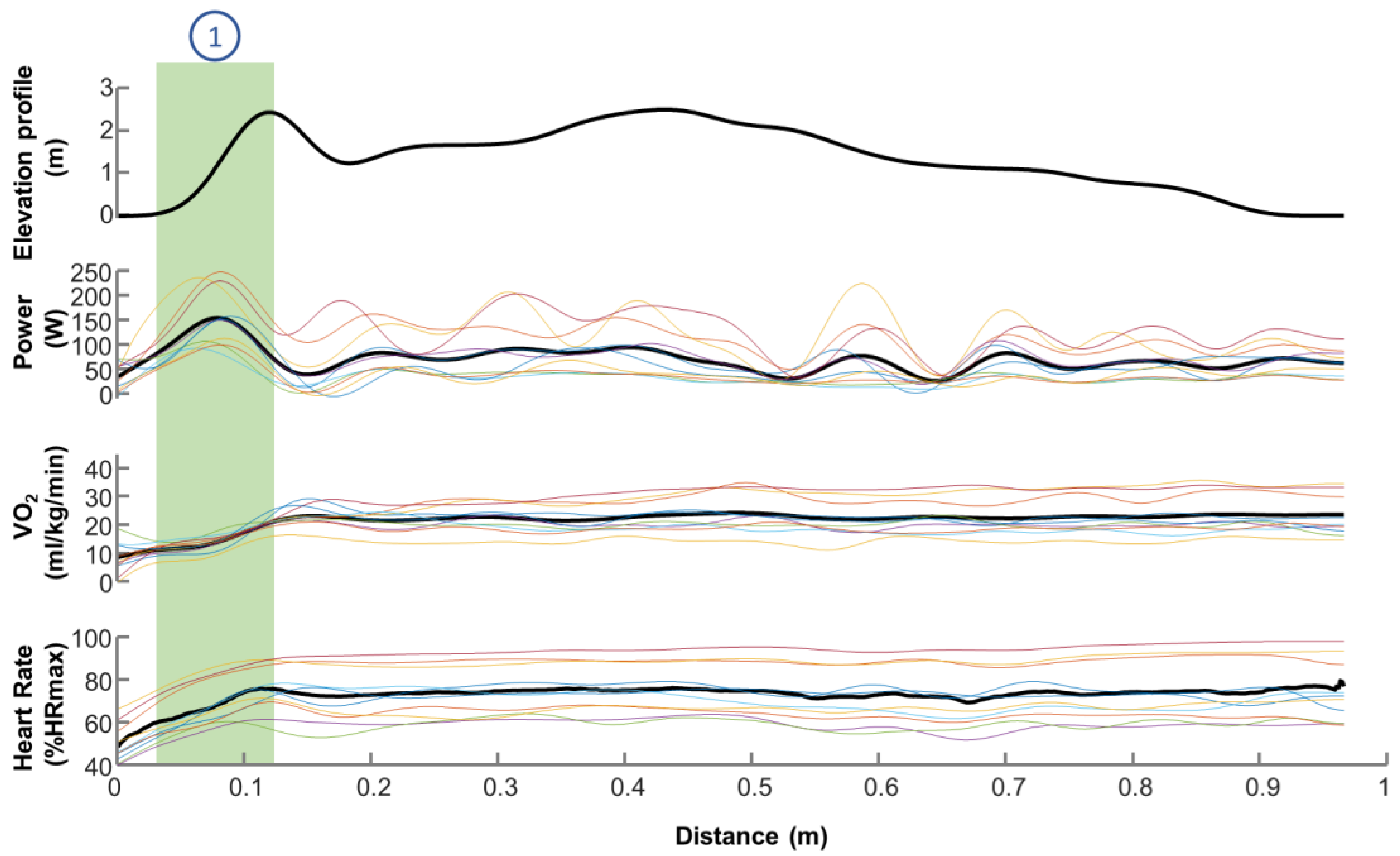Handbike Riding in the Brescia Urban Loose Space: Topographical Evaluation and Metabolic Demand Estimation of Four Suitable Tracks
Abstract
1. Introduction
2. Materials and Methods
2.1. Subject Enrollment and Track Description
2.2. Study Design
2.3. Metabolimeter Calibration and Sanitation
2.4. Data Analysis
2.5. Statistical Analysis
3. Results
3.1. Track Topographical Characteristics and Specific Ergometabolic Demand
3.2. PA Feasible on the Tracks
4. Discussion
4.1. Track Characteristics
4.2. Required Mechanical Power and Ergometabolic Demand
4.3. Urban Infrastructures and Leisure Time PA
4.4. Structured PA
4.5. Limitations
5. Conclusions
Author Contributions
Funding
Institutional Review Board Statement
Informed Consent Statement
Data Availability Statement
Acknowledgments
Conflicts of Interest
References
- Yumuk, V.; Tsigos, C.; Fried, M.; Schindler, K.; Busetto, L.; Micic, D.; Toplak, H.; Obesity Management Task Force of the European Association for the Study of Obesity. European Guidelines for Obesity Management in Adults. Obes. Facts 2015, 8, 402–424. [Google Scholar] [CrossRef] [PubMed]
- Jakicic, J.M.; Davis, K.K. Obesity and Physical Activity. Psychiatr. Clin. N. Am. 2011, 34, 829–840. [Google Scholar] [CrossRef]
- Lee, I.-M.; Shiroma, E.J.; Lobelo, F.; Puska, P.; Blair, S.N.; Katzmarzyk, P.T.; Lancet Physical Activity Series Working Group. Effect of Physical Inactivity on Major Non-Communicable Diseases Worldwide: An Analysis of Burden of Disease and Life Expectancy. Lancet 2012, 380, 219–229. [Google Scholar] [CrossRef] [PubMed]
- World Health Organization. Global Action Plan for the Prevention and Control of Noncommunicable Diseases 2013–2020; World Health Organization: Geneva, Switzerland, 2013; ISBN 9789241506236. [Google Scholar]
- Lees, S.J.; Booth, F.W. Physical Inactivity Is a Disease. World Rev. Nutr. Diet. 2005, 95, 73–79. [Google Scholar] [CrossRef] [PubMed]
- Lees, S.J.; Booth, F.W. Sedentary Death Syndrome. Can. J. Appl. Physiol. 2004, 29, 447–460; discussion 444–446. [Google Scholar] [CrossRef] [PubMed]
- Bull, F.; Saad Al-Ansari, S.; Biddle, S.; Borodulin, K.; Buman, M.; Cardon, G.; Carty, C.; Chaput, J.-P.; Chastin, S.; Chou, R.; et al. World Health Organization 2020 Guidelines on Physical Activity and Sedentary Behaviour. Br. J. Sports Med. 2020, 54, 1451–1462. [Google Scholar] [CrossRef] [PubMed]
- Bayles, M. ACSM’s Exercise Testing and Prescription; Lippincott Williams & Wilkins: Philadelphia, PA, USA, 2023. [Google Scholar]
- World Health Organization. WHO Guidelines on Physical Activity and Sedentary Behaviour; World Health Organization: Geneva, Switzerland, 2020. [Google Scholar]
- Foster, C.; Farland, C.V.; Guidotti, F.; Harbin, M.; Roberts, B.; Schuette, J.; Tuuri, A.; Doberstein, S.T.; Porcari, J.P. The Effects of High Intensity Interval Training vs. Steady State Training on Aerobic and Anaerobic Capacity. J. Sports Sci. Med. 2015, 14, 747–755. [Google Scholar] [PubMed]
- Hwang, C.-L.; Lim, J.; Yoo, J.-K.; Kim, H.-K.; Hwang, M.-H.; Handberg, E.M.; Petersen, J.W.; Holmer, B.J.; Leey Casella, J.A.; Cusi, K.; et al. Effect of All-Extremity High-Intensity Interval Training vs. Moderate-Intensity Continuous Training on Aerobic Fitness in Middle-Aged and Older Adults with Type 2 Diabetes: A Randomized Controlled Trial. Exp. Gerontol. 2019, 116, 46–53. [Google Scholar] [CrossRef]
- Batool, T.; Ross, V.; Van Blerk, J.; Neven, A.; Dendale, P.; Janssens, D.; Wets, G.; Brijs, K. Promoting Sustainable Transportation: A Transtheoretical Examination of Active Transport Modes. Sustainability 2024, 16, 472. [Google Scholar] [CrossRef]
- Fetting, C. The European Green Deal; ESDN Office: Vienna, Austria, 2020. [Google Scholar]
- Monti, A. Urban Cycling Mobility in the European Green Deal. J. Eur. Environ. Plan. Law 2022, 19, 55–73. [Google Scholar] [CrossRef]
- Franck, K.A.; Stevens, Q. Loose Space: Possibility and Diversity in Urban Life. In Loose Space: Possibility and Diversity in Urban Life; Routledge: London, UK, 2006; pp. 1–303. [Google Scholar] [CrossRef]
- Maki, K.C.; Langbein, W.E.; Reid-Lokos, C. Energy Cost and Locomotive Economy of Handbike and Rowcycle Propulsion by Persons with Spinal Cord Injury. J. Rehabil. Res. Dev. 1995, 32, 170–178. [Google Scholar] [PubMed]
- Cogliati, M.; Cudicio, A.; Negro, F.; Gaffurini, P.; Bissolotti, L.M.; Orizio, C. Influence of Age on Motor Control Accuracy during Static Ramp Contractions. Exp. Brain Res. 2019, 237, 1889–1897. [Google Scholar] [CrossRef] [PubMed]
- Tinetti, M.E.; Speechley, M.; Ginter, S.F. Risk Factors for Falls among Elderly Persons Living in the Community. N. Engl. J. Med. 1988, 319, 1701–1707. [Google Scholar] [CrossRef] [PubMed]
- Cogliati, M.; Cudicio, A.; Benedini, M.; Cabral, H.V.; Negro, F.; Reggiani, C.; Orizio, C. Influence of Age on Force and Re-Lengthening Dynamics after Tetanic Stimulation Withdrawal in the Tibialis Anterior Muscle. Eur. J. Appl. Physiol. 2023, 123, 1825–1836. [Google Scholar] [CrossRef] [PubMed]
- Guralnik, J.M.; Ferrucci, L.; Pieper, C.F.; Leveille, S.G.; Markides, K.S.; Ostir, G.V.; Studenski, S.; Berkman, L.F.; Wallace, R.B. Lower Extremity Function and Subsequent Disability: Consistency across Studies, Predictive Models, and Value of Gait Speed Alone Compared with the Short Physical Performance Battery. J. Gerontol. A Biol. Sci. Med. Sci. 2000, 55, M221–M231. [Google Scholar] [CrossRef]
- Kim, D.-I.; Lee, H.; Lee, B.-S.; Kim, J.; Jeon, J.Y. Effects of a 6-Week Indoor Hand-Bike Exercise Program on Health and Fitness Levels in People with Spinal Cord Injury: A Randomized Controlled Trial Study. Arch. Phys. Med. Rehabil. 2015, 96, 2033–2040.e1. [Google Scholar] [CrossRef]
- Valent, L.J.; Dallmeijer, A.J.; Houdijk, H.; Slootman, H.J.; Post, M.W.; van der Woude, L.H. Influence of Hand Cycling on Physical Capacity in the Rehabilitation of Persons with a Spinal Cord Injury: A Longitudinal Cohort Study. Arch. Phys. Med. Rehabil. 2008, 89, 1016–1022. [Google Scholar] [CrossRef]
- Kerr, J.; Sallis, J.F.; Saelens, B.E.; Cain, K.L.; Conway, T.L.; Frank, L.D.; King, A.C. Outdoor Physical Activity and Self Rated Health in Older Adults Living in Two Regions of the U.S. Int. J. Behav. Nutr. Phys. Act. 2012, 9, 89. [Google Scholar] [CrossRef]
- Wicks, C.; Barton, J.; Orbell, S.; Andrews, L. Psychological Benefits of Outdoor Physical Activity in Natural versus Urban Environments: A Systematic Review and Meta-Analysis of Experimental Studies. Appl. Psychol. Health Well-Being 2022, 14, 1037–1061. [Google Scholar] [CrossRef]
- Thompson Coon, J.; Boddy, K.; Stein, K.; Whear, R.; Barton, J.; Depledge, M.H. Does Participating in Physical Activity in Outdoor Natural Environments Have a Greater Effect on Physical and Mental Wellbeing than Physical Activity Indoors? A Systematic Review. Environ. Sci. Technol. 2011, 45, 1761–1772. [Google Scholar] [CrossRef]
- Arnet, U.; Hinrichs, T.; Lay, V.; Bertschy, S.; Frei, H.; Brinkhof, M.W.G.; SwiSCI Study Group. Determinants of Handbike Use in Persons with Spinal Cord Injury: Results of a Community Survey in Switzerland. Disabil. Rehabil. 2016, 38, 81–86. [Google Scholar] [CrossRef] [PubMed]
- Abel, T.; Kröner, M.; Rojas Vega, S.; Peters, C.; Klose, C.; Platen, P. Energy Expenditure in Wheelchair Racing and Handbiking—A Basis for Prevention of Cardiovascular Diseases in Those with Disabilities. Eur. J. Cardiovasc. Prev. Rehabil. 2003, 10, 371–376. [Google Scholar] [CrossRef] [PubMed]
- Hoekstra, S.; Valent, L.; Gobets, D.; van der Woude, L.; de Groot, S. Effects of Four-Month Handbike Training under Free-Living Conditions on Physical Fitness and Health in Wheelchair Users. Disabil. Rehabil. 2017, 39, 1581–1588. [Google Scholar] [CrossRef] [PubMed]
- Marcolin, G.; Cogliati, M.; Cudicio, A.; Negro, F.; Tonin, R.; Orizio, C.; Paoli, A. Neuromuscular Fatigue Affects Calf Muscle Activation Strategies, but Not Dynamic Postural Balance Control in Healthy Young Adults. Front. Physiol. 2022, 13, 799565. [Google Scholar] [CrossRef] [PubMed]
- Cudicio, A.; Girardello, A.; Negro, F.; Orizio, C.; Arenghi, A.; Legnani, G.; Serpelloni, M. Topographical and Physiological Data Collection for Urban Handbike Tracks Design. In Pedestrians, Urban Spaces and Health, Proccedings of the 24th International Conference on Living and Walking in Cities, LWC 2019, Brescia, Italy, 12–13 September 2019; CRC Press: Boca Raton, FL, USA, 2019; pp. 225–229. [Google Scholar] [CrossRef]
- Tanaka, H.; Monahan, K.D.; Seals, D.R. Age-Predicted Maximal Heart Rate Revisited. J. Am. Coll. Cardiol. 2001, 37, 153–156. [Google Scholar] [CrossRef] [PubMed]
- Borgogni, A. Gli Spazi Pubblici Come Luoghi Educativi: Autonomia, Mobilità Indipendente e Stili Di Vita Attivi Nei Bambini. Pedagog. Oggi 2019, XVII, 277–292. [Google Scholar]
- Åstrand, P. Textbook of Work Physiology: Physiological Bases of Exercise; Human Kinetics: Champaign, IL, USA, 2003. [Google Scholar]
- Kang, J.; Robertson, R.J.; Goss, F.L.; Dasilva, S.G.; Suminski, R.R.; Utter, A.C.; Zoeller, R.F.; Metz, K.F. Metabolic Efficiency during Arm and Leg Exercise at the Same Relative Intensities. Med. Sci. Sports Exerc. 1997, 29, 377–382. [Google Scholar] [CrossRef] [PubMed]
- Calbet, J.A.L.; Holmberg, H.-C.; Rosdahl, H.; van Hall, G.; Jensen-Urstad, M.; Saltin, B. Why Do Arms Extract Less Oxygen than Legs during Exercise? Am. J. Physiol. Regul. Integr. Comp. Physiol. 2005, 289, R1448–R1458. [Google Scholar] [CrossRef]
- Eston, R.G.; Brodie, D.A. Responses to Arm and Leg Ergometry. Br. J. Sports Med. 1986, 20, 4–6. [Google Scholar] [CrossRef]
- Paton, C.D.; Hopkins, W.G. Tests of Cycling Performance. Sports Med. 2001, 31, 489–496. [Google Scholar] [CrossRef]
- di Prampero, P.E. Cycling on Earth, in Space, on the Moon. Eur. J. Appl. Physiol. 2000, 82, 345–360. [Google Scholar] [CrossRef] [PubMed]
- Debraux, P.; Grappe, F.; Manolova, A.V.; Bertucci, W. Aerodynamic Drag in Cycling: Methods of Assessment. Sports Biomech. 2011, 10, 197–218. [Google Scholar] [CrossRef] [PubMed]
- García-López, J.; Rodríguez-Marroyo, J.A.; Juneau, C.-E.; Peleteiro, J.; Martínez, A.C.; Villa, J.G. Reference Values and Improvement of Aerodynamic Drag in Professional Cyclists. J. Sports Sci. 2008, 26, 277–286. [Google Scholar] [CrossRef] [PubMed]
- Davies, C.T. Effect of Air Resistance on the Metabolic Cost and Performance of Cycling. Eur. J. Appl. Physiol. Occup. Physiol. 1980, 45, 245–254. [Google Scholar] [CrossRef]
- ISTAT. Conoscere Il Mondo Della Disabilità: Persone, Relazioni E Istituzioni; ISTAT: Rome, Italy, 2019; ISBN 978-88-458-2005-2. [Google Scholar]
- Jörgensen, S.; Martin Ginis, K.A.; Lexell, J. Leisure Time Physical Activity among Older Adults with Long-Term Spinal Cord Injury. Spinal Cord. 2017, 55, 848–856. [Google Scholar] [CrossRef]
- Rocchi, M.; Routhier, F.; Latimer-Cheung, A.E.; Ginis, K.A.M.; Noreau, L.; Sweet, S.N. Are Adults with Spinal Cord Injury Meeting the Spinal Cord Injury-Specific Physical Activity Guidelines? A Look at a Sample from a Canadian Province. Spinal Cord. 2017, 55, 454–459. [Google Scholar] [CrossRef]
- Maher, J.L.; McMillan, D.W.; Nash, M.S. Exercise and Health-Related Risks of Physical Deconditioning after Spinal Cord Injury. Top. Spinal Cord. Inj. Rehabil. 2017, 23, 175–187. [Google Scholar] [CrossRef]
- Martin Ginis, K.A.; van der Ploeg, H.P.; Foster, C.; Lai, B.; McBride, C.B.; Ng, K.; Pratt, M.; Shirazipour, C.H.; Smith, B.; Vásquez, P.M.; et al. Participation of People Living with Disabilities in Physical Activity: A Global Perspective. Lancet 2021, 398, 443–455. [Google Scholar] [CrossRef]
- Hicks, A.L.; Martin, K.A.; Ditor, D.S.; Latimer, A.E.; Craven, C.; Bugaresti, J.; McCartney, N. Long-Term Exercise Training in Persons with Spinal Cord Injury: Effects on Strength, Arm Ergometry Performance and Psychological Well-Being. Spinal Cord. 2003, 41, 34–43. [Google Scholar] [CrossRef]
- Nooijen, C.F.; Stam, H.J.; Sluis, T.; Valent, L.; Twisk, J.; van den Berg-Emons, R.J. A Behavioral Intervention Promoting Physical Activity in People with Subacute Spinal Cord Injury: Secondary Effects on Health, Social Participation and Quality of Life. Clin. Rehabil. 2017, 31, 772–780. [Google Scholar] [CrossRef]
- Stevens, S.L.; Caputo, J.L.; Fuller, D.K.; Morgan, D.W. Physical Activity and Quality of Life in Adults with Spinal Cord Injury. J. Spinal Cord. Med. 2008, 31, 373–378. [Google Scholar] [CrossRef]
- Kawanishi, C.Y.; Greguol, M. Physical Activity, Quality of Life, and Functional Autonomy of Adults with Spinal Cord Injuries. Adapt. Phys. Act. Q. APAQ 2013, 30, 317–337. [Google Scholar] [CrossRef] [PubMed]
- Marquart, H.; Schuppan, J. Promoting Sustainable Mobility: To What Extent Is “Health” Considered by Mobility App Studies? A Review and a Conceptual Framework. Sustainability 2021, 14, 47. [Google Scholar] [CrossRef]
- Wałdykowski, P.; Adamczyk, J.; Dorotkiewicz, M. Sustainable Urban Transport—Why a Fast Investment in a Complete Cycling Network Is Most Profitable for a City. Sustainability 2021, 14, 119. [Google Scholar] [CrossRef]
- Borgogni, A. L’intenzionalità Educativa Degli Spazi Pubblici: Luoghi e Tempi Delle Didattiche Del Movimento. In L’intenzionalità Educativa Degli Spazi Pubblici; Studium: New Delhi, India, 2020. [Google Scholar]
- Chung, N.; Park, M.-Y.; Kim, J.; Park, H.-Y.; Hwang, H.; Lee, C.-H.; Han, J.-S.; So, J.; Park, J.; Lim, K. Non-Exercise Activity Thermogenesis (NEAT): A Component of Total Daily Energy Expenditure. J. Exerc. Nutrition Biochem. 2018, 22, 23–30. [Google Scholar] [CrossRef]
- Teske, J.A.; Billington, C.J.; Kuskowski, M.A.; Kotz, C.M. Spontaneous Physical Activity Protects against Fat Mass Gain. Int J Obes. 2012, 36, 603–613. [Google Scholar] [CrossRef]
- Kriemler, S.; Hebestreit, H.; Mikami, S.; Bar-Or, T.; Ayub, B.V.; Bar-Or, O. Impact of a Single Exercise Bout on Energy Expenditure and Spontaneous Physical Activity of Obese Boys. Pediatr. Res. 1999, 46, 40–44. [Google Scholar] [CrossRef][Green Version]
- Garland, T.; Schutz, H.; Chappell, M.A.; Keeney, B.K.; Meek, T.H.; Copes, L.E.; Acosta, W.; Drenowatz, C.; Maciel, R.C.; van Dijk, G.; et al. The Biological Control of Voluntary Exercise, Spontaneous Physical Activity and Daily Energy Expenditure in Relation to Obesity: Human and Rodent Perspectives. J. Exp. Biol. 2011, 214, 206–229. [Google Scholar] [CrossRef]
- Ruegsegger, G.N.; Booth, F.W. Health Benefits of Exercise. Cold Spring Harb. Perspect. Med. 2018, 8, a029694. [Google Scholar] [CrossRef]
- Adamu, B.; Sani, M.U.; Abdu, A. Physical Exercise and Health: A Review. Niger. J. Med. 2006, 15, 190–196. [Google Scholar] [CrossRef]







| Mean Power (W) | Peak Power (W) | Mean Speed (Km/h) | Mean Cadence (RPM) | Length (m) | Elevation Gain (m) | Slope (%) | ||
|---|---|---|---|---|---|---|---|---|
| Track 1 | ASCENT 1 | 84.45 ± 15.75 | 162.43 ± 53.12 | 14.51 ± 2.88 | 48.90 ± 6 | 341 | 4.29 | 1.26 |
| ASCENT 2 | 81.90 ± 17.87 | 141.90 ± 42.96 | 12.58 ± 1.34 | 48.20 ± 8 | 109 | 1.17 | 1.07 | |
| ASCENT 3 | 83.94 ± 19.67 | 153.34 ± 22.96 | 13.90 ± 1.44 | 44.86 ± 5 | 88 | 1.34 | 1.53 | |
| ASCENT 4 | 79.79 ± 11.96 | 127.10 ± 33.78 | 12.71 ± 1.61 | 45.17 ± 4 | 126 | 1.65 | 1.31 | |
| ASCENT 5 | 87.09 ± 9.33 | 136.79 ± 29.49 | 15.25 ± 2.26 | 52.13 ± 2 | 122 | 1.95 | 1.60 | |
| Track 2 | ASCENT 1 | 119.24 ± 29.79 | 205.45 ± 65.64 | 13.94 ± 0.55 | 68.96 ± 4 | 222 | 3.46 | 1.56 |
| Track 3 | ASCENT 1 | 120.01 ± 46.66 | 252.52 ± 81.22 | 11.67 ± 1.66 | 62.29 ± 8 | 98 | 2.42 | 2.47 |
| Track 4 | ASCENT 1 | 97.55 ± 24.54 | 167.54 ± 32.55 | 13.74 ± 0.89 | 61.39 ± 10 | 92 | 1.42 | 1.54 |
| ASCENT 2 | 93.10 ± 33.08 | 187.27 ± 41.12 | 10.33 ± 2.52 | 60.35 ± 5 | 120 | 3.60 | 3.00 |
Disclaimer/Publisher’s Note: The statements, opinions and data contained in all publications are solely those of the individual author(s) and contributor(s) and not of MDPI and/or the editor(s). MDPI and/or the editor(s) disclaim responsibility for any injury to people or property resulting from any ideas, methods, instructions or products referred to in the content. |
© 2024 by the authors. Licensee MDPI, Basel, Switzerland. This article is an open access article distributed under the terms and conditions of the Creative Commons Attribution (CC BY) license (https://creativecommons.org/licenses/by/4.0/).
Share and Cite
Cudicio, A.; Cogliati, M.; Bonardi, A.; Agosti, V.; Borgogni, A.; Orizio, C. Handbike Riding in the Brescia Urban Loose Space: Topographical Evaluation and Metabolic Demand Estimation of Four Suitable Tracks. Sustainability 2024, 16, 889. https://doi.org/10.3390/su16020889
Cudicio A, Cogliati M, Bonardi A, Agosti V, Borgogni A, Orizio C. Handbike Riding in the Brescia Urban Loose Space: Topographical Evaluation and Metabolic Demand Estimation of Four Suitable Tracks. Sustainability. 2024; 16(2):889. https://doi.org/10.3390/su16020889
Chicago/Turabian StyleCudicio, Alessandro, Marta Cogliati, Alberto Bonardi, Valeria Agosti, Antonio Borgogni, and Claudio Orizio. 2024. "Handbike Riding in the Brescia Urban Loose Space: Topographical Evaluation and Metabolic Demand Estimation of Four Suitable Tracks" Sustainability 16, no. 2: 889. https://doi.org/10.3390/su16020889
APA StyleCudicio, A., Cogliati, M., Bonardi, A., Agosti, V., Borgogni, A., & Orizio, C. (2024). Handbike Riding in the Brescia Urban Loose Space: Topographical Evaluation and Metabolic Demand Estimation of Four Suitable Tracks. Sustainability, 16(2), 889. https://doi.org/10.3390/su16020889





